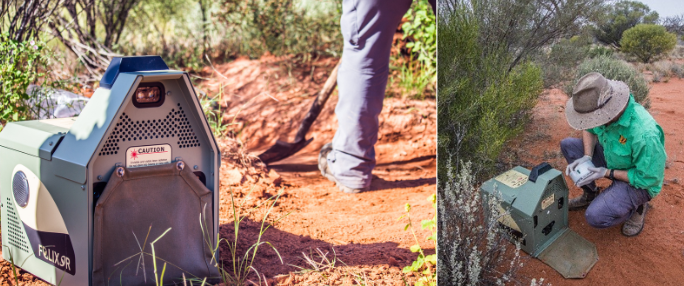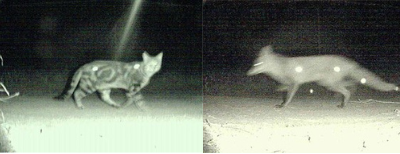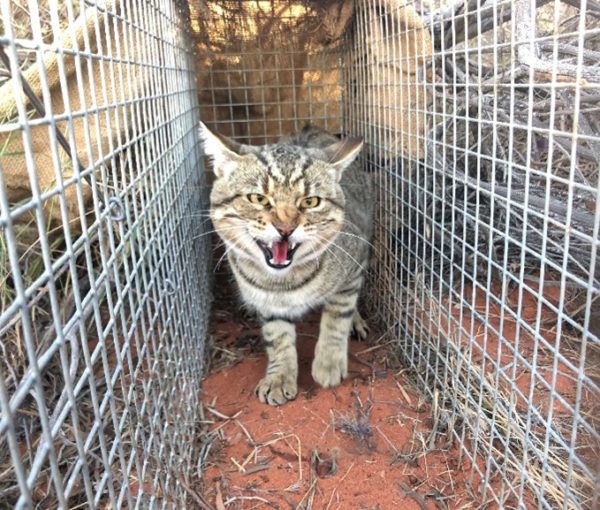Thylation grant gets more Felixers
Nathan Manders
03 January 2023

Controlling feral animals is a big job that requires a lot of time and effort. Best results are only achieved when you use all the tools at your disposal, and at Arid Recovery the Felixer is one of those tools.
Thanks to funding from Thylation, & the Invasive Species Council, Arid Recovery has extra Felixers helping protect the newly reintroduced population of kowaris from feral cats.
Based on their size and habitat, kowaris have been judged to be in the very top echelon of mammals at risk from cat predation. Many other similar sized animals have trees and other cover to help them escape from cats, but not so for the kowari in its open arid habitat.
The juvenile kowaris from the winter 2022 reintroduction are dispersing now. Some will inevitably go through the Arid Recovery fence, and thanks to several years of good rains, cats are very common around the reserve at the moment. The Felixers will help create a buffer for them and improve their chances of survival.
 Kowari being released
Kowari being released
What is a Felixer and how does it work?
The Felixer is a solar powered grooming trap specifically designed to target feral cats and foxes by spraying 1080 gel on to the target. Catsare fastidious groomers, so when the gel is fired onto their fur, they will instinctively lick it off and ingest the poison.
The Felixer uses sensors to detect objects that pass in front of it as well as a software algorithm to distinguish between its target species of cats & foxes and other non-target animals and objects. When a target animal is detected, a firing pin will release onto one of the sealed 1080 cartridges from the 20-round magazine, shooting the gel directly onto the target.
The Felixer also comes with an in-built camera that will take a photo of anything that passes in front of it.
 Left: To set up the felixer, you need to ensure the ground is level.
Left: To set up the felixer, you need to ensure the ground is level.
Right: Loading the cartridges into the magazine
How does Arid Recovery use the Felixer?
The Arid Recovery reserve boundary is lined with a network of cage traps to target cats that patrol the reserve fences. And while these traps are numerous and largely effective, you will still naturally get cats that will either miss the traps or, more importantly, will be too trap-shy to enter one. This is where a tool like the Felixer really comes in handy.
We will generally position the Felixer just beside a track or a trail where cats/foxes are known, or likely to travel along. And using surrounding bushes we can obscure the Felixer from animals approaching from either direction. With the Felixer’s in-built audio lures we can also lure the target animals in the direction of the Felixer.
When it comes to choosing a site to set up the Felixer, it is as much about site preparation as it is location. In my experience it’s best to use a track or trail with a solid base and to have something solid like a big rock, tree or bushes to set the Felixer up against. Most sites will require some shovel work to make the ground nice and level to ensure all the laser sensors have a clear path with no obstructions.
Once the Felixer is set in the field it is checked periodically to see whether it has had any firings, to clean and maintain it and to update firmware. When doing this, a new USB with updated firmware is put in and all the data from the old USB is uploaded onto an online management system. Once the USB data has been uploaded the photos can be classified. When uploaded, the data can then be accessed and used for diagnostics and performance.
Over the last 18 months we have had one Felixer set up on the perimeter and in that time it has fired on 26 cats and 2 foxes. Because they do not require manual resetting like conventional traps, Felixers are particularly valuable for remote parts of our fenceline that we don’t otherwise need to drive past every day. A cat and fox being fired upon with the Felixer
A cat and fox being fired upon with the Felixer

Non-target animals such as the kangaroo and biliby NOT being fired on.
A brief history
The concept of the Felixer was developed by Dr John Read, co-founder of the Arid Recovery Reserve and founder of the Thylation group of companies.
Back in 2017, Arid Recovery hosted the largest Felixer effectiveness trial. The trial used 20 Felixers within a 2,600-ha fenced area where cats were present and was conducted over 6 weeks. Over the 6-week trial, over 1,000 non-target species passed in front of the Felixers with none of them being fired on. Thirty-three targets (cats) were fired on, with 22 of those being distinguishable individuals that were not picked up on cameras after being fired upon, suggesting they died after firing. Some of the cats in the area were radio-collared, and two of these were confirmed dead after being fired on. Data and estimates suggested that about two thirds of the cats in the area had been killed by the Felixer over the 6-week period.
 Feral cat in a trap
Feral cat in a trap